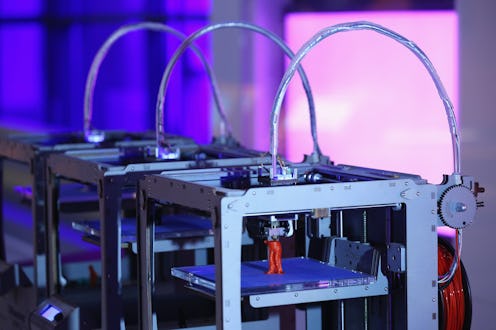Life
Scientists Can 3D-Print Ears, Jaws & Muscles Now
In the last few years, 3D printing has introduced new ways to make food, design fashion, and even build houses, but recent research suggests that it may also have a hand in a science-fiction-esque future in which human organs and limbs can be printed from scratch. A new study published in Nature Biotechnology reveals that scientists have invented a 3D printer capable of printing cartilage, muscle, and even bone. Called the “Integrated Tissue and Organ Printing System,” or “ITOP,” this “bioprinter” is able to create implantable, living tissue, which in the future could lead to the development of synthetic organs and even “replacement body parts,” according to Discovery News.
Previous researchers have attempted to create bodily tissues through 3D printing, but they have had to grapple with two major challenges: First, previous “printed” tissue has had to be very thin, because tissue needs blood vessels (which supply necessary oxygen and nutrients) to survive. Thicker printed tissues lack the complex capillary systems of natural tissue, and thus can’t get adequate supply of the blood they need. (In fact, last week, another paper addressed this very problem with artificial tissue. In that study, researchers are attempting to create synthetic capillary beds with modified cotton candy machines). Second, the tissue that these bioprinters have created has typically been very unstable and therefore unsuited to actual use.
ITOP manages to get around these problems to create stable, living tissue in a variety of shapes. The machine was created by researchers at the Wake Forest Institute for Regenerative Medicine, led by Anthony Atala. ITOP incorporates a web of tiny channels into the tissue that it prints, allowing oxygen and nutrients to reach the cells that need them, regardless of how thick the tissue is. And, while previous attempts at printed tissue have been fragile, ITOP maintains the stability of its tissue by creating “scaffolding” for cells. The printer uses two different substances: A hard, biodegradable plastic and a hydrogel. The gel is a good environment for living cells, but it’s not structurally sound on its own. The harder plastic thus creates a framework for the gel, keeping the whole structure secure. Once the cells grow more stable, the plastic structure breaks down. “Basically we're printing a thread of hard [plastic], then a bead of these soft cells intermittently. So: hard, soft, hard, soft,” Atala told Popular Mechanics. He explained, “This is very important. This process allows the tissues we print to keep the structural integrity necessary to implant inside the body.”
So far, ITOP’s bioprinted tissues have not been tested on humans, but trials conducted on animals have shown promise for eventual use in humans. For instance, the researchers printed human-sized ears and implanted them on mice. After two months, the ears had kept their shape and had formed blood vessels and cartilage tissue. In another trial, the scientists used human stem cells to create fragments of jaw bones and implanted them in rats. Five months later, the fragments had developed bone tissue along with blood vessels.
The study was funded by the Armed Forces Institute of Regenerative Medicine, in hopes that it could eventually lead to advancements that might aid battlefield injuries. In a press release, Atala said,
This novel tissue and organ printer is an important advance in our quest to make replacement tissue for patients. It can fabricate stable, human-scale tissue of any shape. With further development, this technology could potentially be used to print living tissue and organ structures for surgical implantation.
You can check out ITOP in action below:
